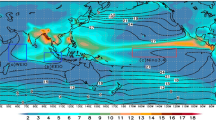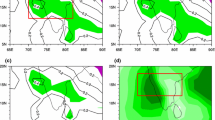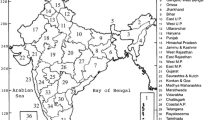Abstract
Indo-Pacific Ocean sea surface temperature (SST) anomalies in the form of Indian Ocean Dipole (IOD) and El Niño-Southern Oscillation (ENSO) have a major role in determining the climate of the tropics and extratropics. The tropical Pacific variability was dominated by canonical ENSO (EOF1) and El Niño Modoki (EOF2) during the 1980–1998 period (period 1), while during the 1999–2017 period (period 2), both the flavors of ENSO contributed to EOF1. This Pacific Ocean variability weakened the ENSO-IOD relationship also. The present study estimates the changes that occurred to the major modes of Asian summer monsoon (ASM) rainfall during these two periods and addresses the role of the recent changes in SST boundary forcing in ASM interannual variability. During period 1, the first mode (EOF1) of ASM rainfall was associated with ENSO and IOD with 32% variability. But after 1998, EOF1 depends only on the ENSO flavors (canonical and Modoki ENSO) and has slightly reduced variability (26%). The second mode was controlled by the decay phase of ENSO during the 1980–1998 period (12%), while the eastern Indian Ocean and central-northeast Pacific SST variability contributed to EOF2 (15%) during period 2. EOF3 is controlled by IOD in both periods. Further analysis indicates that the extended warming pattern from central to eastern Pacific of ENSO during period 2 weakened ENSO-IOD co-occurrence through the modification of tropical circulation. In the absence of IOD, ENSO-monsoon teleconnection becomes stronger during period 2 than in the previous period. Indian summer monsoon rainfall (ISMR) relationship with the developing phase of ENSO became stronger after 1998, and that of the decay phase of ENSO is decreased. The ISMR-ENSO Modoki relationship has a phase shift from summer maxima to winter maxima. Meanwhile, the ISMR-IOD relationship in the absence of ENSO became slightly stronger in the 1999–2017 period. Thus, the Pacific variability in these two periods influenced ASM rainfall variability through the modulation of its relationship with tropical Indo-Pacific SST anomalies.









Similar content being viewed by others
References
Allan R, Chambers D, Drosdowsky W, Hendon H, Latif M, Nicholls N, Smith I, Stone R, Tourre Y (2001) Is there an Indian Ocean dipole and is it independent of El Niño- southern oscillation? Clivar Exchanges 6:18–22
Annamalai H, Hamilton K, Sperber KR (2007) The south Asian summer monsoon and its relationship with ENSO in the IPCC AR4 Simulations. J Clim 20:1071–1092
Ashok K, Guan Z, Yamagata T (2001) Impact of the Indian Ocean Dipole on the relationship between the Indian monsoon rainfall and ENSO. Geophys Res Lett 28:4499–4502
Ashok K, Guan Z, Yamagata T (2004) A look at the relationship between the ENSO and the Indian Ocean dipole. J Meteorol Soc Jpn 81:41–56
Ashok K, Nakamura H, Yamagata T (2007) Impacts of ENSO and Indian Ocean dipole events on the southern hemisphere storm-track activity during austral winter. J Clim 20:3147–3150
Baquero-Bernal A, Latif M, Legutke S (2002) On dipole like variability of sea surface temperature in the tropical Indian Ocean. J Clim 15:1358–1368
Behera SK, Yamagata T (2002) Impact of the Indian Ocean dipole on the southern oscillation. J Meteorol Soc Jpn 81:169–177
Boschat G, Terray P, Masson S (2012) Robustness of SST teleconnections and precursory patterns associated with the Indian summer monsoon. Clim Dyn 38:2143–2165
Chang P, Yamagata T, Schopf P, Behera SK, Carton J, Kessler WS, Meyers G, Qu T, Schott F, Shetye S, Xie SP (2006) Climate fluctuations of tropical coupled systems—the role of ocean dynamics. J Clim 19:5122–5174
Chung PH, Li T (2013) Interdecadal relationship between the mean state and El Niño types. J Clim 26:361–379
Dee DP et al (2011) The ERA-interim reanalysis: configuration and performance of the data assimilation system. Quart J Roy Meteor Soc 137:553–597. https://doi.org/10.1002/qj.828
Devika MN, Pillai PA (2020) Recent changes in the trend, prominent modes and the interannual variability of Indian summer monsoon rainfall centered on the early 21st century. Theor Appl Climatol 139:815–824
Endo S, Tozuka T (2016) Two flavors of Indian Ocean Dipole. Clim Dyn 46:3371–3385
Feng M, McPhaden MJ, Lee T (2010) Decadal variability of the Pacific subtropical cells and their influence on the southeast Indian Ocean. Geophys Res Lett 37:L09606. https://doi.org/10.1029/2010GL042796
Ham YG, Choi JY, Kug JS (2017) The weakening of the ENSO-Indian Ocean Dipole (IOD) coupling strength in recent decades. Clim Dyn 49:249–261
Huffman GJ, Adler RF, Bolvin DT, Gu G (2009) Improving the global precipitation record: GPCP Version 2.1. Geophys Res Lett 36:L17808. https://doi.org/10.1029/2009GL040000
Lau N, Nath MJ (2000) Impact of ENSO on the variability of the Asian– Australian monsoons as simulated in GCM experiments. J Clim 13:4287–4309
Lau N, Nath MJ (2003) Atmosphere-ocean variations in the Indo-Pacific sector during ENSO episodes. J Clim 16:3–20
Li Z, Cai W, Lin X (2016) Dynamics of changing impacts of tropical Indo-Pacific variability on Indian and Australian rainfall. Sci Report 6:31767
Luo JJ, Sasaki W, Masumoto Y (2012) Indian Ocean warming modulates Pacific climate change. Proc Natl Acad Sci U S A 109:18 701–18 706. https://doi.org/10.1073/pnas.1210239109
McPhaden MJ, Zebiak SE, Glantz MH (2006) ENSO as an integrating concept in earth science. Science 314:1740–1745
McPhaden MJ, Lee T, McClurg D (2011) El Niño and its relationship to changing background conditions in the tropical Pacific Ocean. Geophys Res Lett 38:L15709
Meehl GA, Arblaster J (2002) The tropospheric biennial oscillation and the Asian-Australian monsoon rainfall. J Clim 15:722–744
Meehl GA, Arblaster JM, Loschnigg J (2003) Coupled Oceanatmosphere dynamical processes in the tropical Indian and Pacific Oceans and the TBO. J Clim 16:2138–2158
Parthasarathy B, Munot AA, Kothawale DR (1995) All India monthly and seasonal rainfall series: 1871-1993. Theor Appl Climatol 49:217–224
Philander SG (1992) Ocean-atmosphere interactions in the tropics: a review of recent theories and models. J Appl Meteorol 31:938–945
Pillai PA, Annamalai H (2012) Moist dynamics of severe monsoons over South Asia: role of the tropical SST. J Atmos Sci 69:97–115
Pillai PA, Mohankumar K (2009) Role of TBO and ENSO scale ocean-atmosphere interaction in the Indo-Pacific region on Asian summer monsoon variability. Theoret And Appl Climatol 97:99–108
Pillai PA, Mohankumar K (2010) Effect of late 1970’s climate shift on tropospheric biennial oscillation – role of local Indian Ocean processes on Asian summer monsoon. Int J Climatol 30:509–521
Pillai PA, Rao SA, George G, Rao DN, Mahapatra S, Rajeevan M, Dhakate A, Salunke K (2017) How distinct are flavors of El Niño in retrospective forecasts of climate forecast system version2(CFSv2)? Clim Dyn 48:3829–3854
Pillai PA, Nair RC, Vidya CV (2019) Recent changes in the prominent modes of Indian Ocean dipole in response to the tropical Pacific Ocean SST patterns. Theoret Appl Climatol 138:941–951
Ramu DA, Chowdary JS, Pillai PA, Sradhara SNS, Koteswararao K, Ramakrishna SSVS (2020) Impact of El Niño Modoki on Indian summer monsoon rainfall: role of western north Pacific circulation in observations and CMIP5 models. Int J Climatol 40:2117–2133
Rasmusson EA, Carpenter TH (1982) Variations in tropical sea surface temperature and surface wind fields associated with the Southern Oscillation/ El Niño. Mon Weather Rev 110:354–384
Rayner NA, Parker DE, Horton EB, Folland CK, Alexander LV, Rowell DP, Kent EC, Kaplan A (2003) Global analyses of sea temperature, sea ice, and night marine air temperature since the last nineteenth century. J Geophys Res: Atmos 108(D14):4407. https://doi.org/10.1029/2002JD002670
Saji NH, Yamagata T (2003) Structure of SST and surface wind variability during Indian Ocean dipole mode events: COADS observations. J Clim 16:2735–2751
Saji NH, Goswami BN, Vinayachandran PN, Yamagata T (1999) A dipole mode in the tropical Indian Ocean. Nature 401:360–363
Shukla J, Paolino DA (1983) The southern oscillation and long-range forecasting of the summer monsoon rainfall over India. Mon Weather Rev 111:1830–1837
Ummenhofer CC, Sen Gupta A, Briggs PR, England MH, McIntosh PC, Meyers GA, Pook MJ, Raupach MR, Risbey JS (2011) Indian and Pacific Ocean influences on southeast Australian drought and soil moisture. J Clim 24:1313–1336
Webster PJ, Magaña VO, Palmer TN, Shukla J, Tomas RA, Yanai M, Yasunari T (1998) Monsoons: Processes, predictability, and the prospects for prediction. Journal of Geophysical Research: Oceans 103 (C7):14451–14510
Webster PJ, Moore A, Loschnigg J, Leban M (1999) Coupled ocean-atmosphere dynamics in the Indian Ocean during 1997-98. Nature 40:356–360
Yamagata T, Behera SK, Luo JJ, Masson S, Jury M, Rao SA (2004) Coupled ocean-atmosphere variability in the tropical Indian Ocean. Earth climate. The ocean-atmosphere interaction. Geophys Monogr 147:189–212
Yuan Y, Li C (2008) Decadal variability of the IOD-ENSO relationship. Chin Sci Bull 53(11):1745–1752
Acknowledgments
Indian Institute of Tropical Meteorology (IITM) is an organization fully funded by the Ministry of Earth Sciences, Govt. of India. The authors acknowledge the Director, IITM for the support. The data set used in the study is downloaded from the respective websites of ECMWF, Met Office. UK and IITM. The plots are created using NCAR Command Language (NCL) and GrADS.
Author information
Authors and Affiliations
Corresponding author
Additional information
Publisher’s note
Springer Nature remains neutral with regard to jurisdictional claims in published maps and institutional affiliations.
Rights and permissions
About this article
Cite this article
Pillai, P.A., Ramu, D.A. & Nair, R.C. Recent changes in the major modes of Asian summer monsoon rainfall: influence of ENSO-IOD relationship. Theor Appl Climatol 143, 869–881 (2021). https://doi.org/10.1007/s00704-020-03454-3
Received:
Accepted:
Published:
Issue Date:
DOI: https://doi.org/10.1007/s00704-020-03454-3




